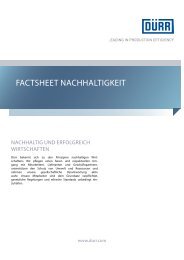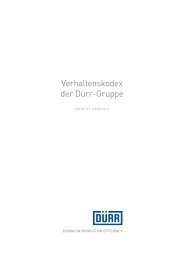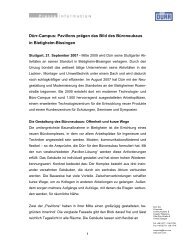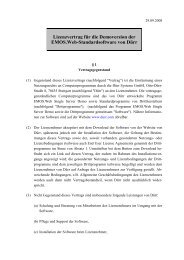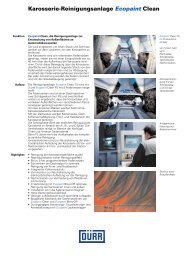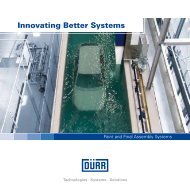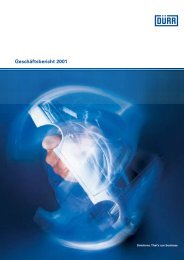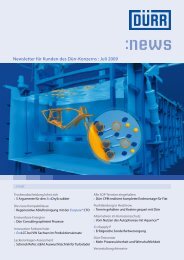Technologies · Systems · Solutions - Dürr
Technologies · Systems · Solutions - Dürr
Technologies · Systems · Solutions - Dürr
You also want an ePaper? Increase the reach of your titles
YUMPU automatically turns print PDFs into web optimized ePapers that Google loves.
92<br />
Impairment test<br />
Government grants<br />
Leases<br />
All intangible assets with an indefinite useful life and goodwill are tested for impairment at the<br />
end of each reporting period. The impairment test is performed annually as of December 31.<br />
Other intangible assets and property, plant and equipment are reviewed for impairment whenever<br />
events or changes in circumstances indicate that the carrying amount of an asset may not<br />
be recoverable.<br />
If the net realizable amount of the asset falls short of the carrying value, an impairment loss is<br />
recognized in the income statement. The recoverable amount is the higher of an asset’s net sales<br />
price and its value in use. The net sales price is the amount recoverable from the disposal of the<br />
asset at customary market conditions less sales costs. Value in use is the fair value of the estimated<br />
future cash flow expected to arise from the continuing use of an asset and from its disposal at<br />
the end of its useful life. The recoverable amount is determined for each asset individually or, if<br />
that is not possible, for the cash-generating unit to which the asset belongs. As regards goodwill<br />
acquired in business combinations, the relevant cash-generating units correspond to the business<br />
units of the <strong>Dürr</strong> Group based on internal reporting structures.<br />
To determine the estimated cash flow of each cash-generating unit, basic assumptions have to<br />
be made. These include assumptions regarding financial planning and the interest rates used for<br />
discounting.<br />
A reversal of impairment losses recognized in prior years is recorded where there is an indication<br />
that the impairment losses recognized for the asset no longer exist or have decreased. The<br />
reversal is posted as a gain to the income statement. The increase in value or the reduction of<br />
an impairment loss of an asset is, however, only recorded to the extent that it does not exceed<br />
the carrying value that would have existed if the regular amortization or depreciation had been<br />
recorded and no impairment losses had been recognized. Write-downs on goodwill recorded as<br />
a result of impairment tests may not be reversed.<br />
According to IAS 20 (Accounting for Government Grants and Disclosure of Government<br />
Assistance), government grants are only recorded if it is reasonably certain that the conditions<br />
attached to the grants will be fulfilled and the grants actually awarded. Grants are deducted<br />
from the carrying amount of the subsidized asset.<br />
The companies in the <strong>Dürr</strong> Group are lessees of land, buildings and office and operating equipment.<br />
The majority of leases are classified as operating leases.<br />
When the leases meet the definition of finance leases, the leased asset is recognized at acquisition<br />
cost (net present value of future minimum lease payments less costs incurred for insurance,<br />
maintenance and taxes on any profit thereon). A liability is also established at that time for the<br />
same amount. The upper limit for the recognition of a leased asset and the liability is its fair value.<br />
The leased asset is depreciated over the shorter of the lease term and its estimated useful life.<br />
Interest is imputed on the obligation using the effective interest method over the lease term.<br />
Lease payments on operating leases are recorded as an expense in the income statement on a<br />
straight-line basis over the term of the lease.




